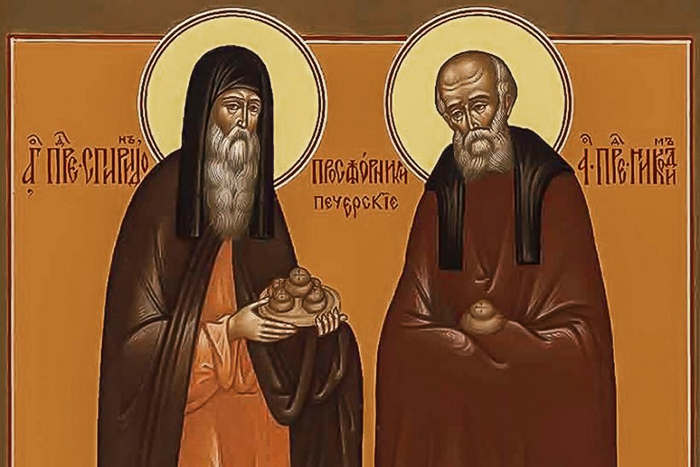
(Lessons from their lives: a) labor should be combined with prayer; b) avoid idleness, and c) use three fingers when making a sign of the cross.)
- St. Spyridon and St. Nicodemus, whose memory is being commemorated today, were in charge of baking prosphoras in the Kiev Caves Lavra and lived in the 12th century. Both of them came from a humble background and did not even know how to read and write. Spyridon entered the monastery in his youth. Because of his high moral integrity, the abbot appointed him to bake prosphoras. Spyridon liked this obedience very much because the prosphoras were prepared for the great Sacrament of the Holy Communion. Spyridon always combined his work with prayer and reading or singing psalms. St. Nicodemus was Spyridon’s co-worker and was as godly as Spyridon. The saints spent 30 years together. Their relics rest in the Anthony Cave. The fingers of St. Spyridon’s right hand are crossed in the same way as in prayer: his first three fingers are joined together, while his middle finger and his little finger are placed on the palm of his hand. This is a lesson for our Old Believers, who usually call for two-finger crossing position!
- There are lots of lessons to learn from the lives of Ss. Spyridon and Nicodemus.
A). Firstly, they teach us how to combine work with prayer.
Labor encourages and is supported by prayer, and prayer leads to labor and is driven by it. St. Anthony the Great, who was struggling with his thoughts in the desert, once asked the Lord from the bottom of his heart: “Lord, show me the way of salvation!” Following some involuntary impulse, he went out of his cave and saw someone like himself who was sitting and working, then stopped to pray, and then sat down again and started working, and then stood up for prayer again. It was an Angel of the Lord, sent to mentor and encourage Anthony. This Angel of God said to him loud and clear, “Do the same, and you will be saved.” “Labor supported by prayer and prayer accompanied by good labor can lead to the salvation of the soul, to which workers should aspire most of all.” (The Memorable Stories on the Works of the Holy Fathers, p. 3, § 1, ed. 1845).
B). Second, the lives of Ss. Spyridon and Nicodemus, who never knew any idleness, teach us to avoid idleness as the most dangerous condition for a Christian.
“Laziness is a sin in itself, for it is contrary to God’s commandments,” St. Tikhon of Zadon preaches. Our forefather Adam was already warned by God, “In the sweat of thy face shalt thou eat bread, till thou return unto the ground; for out of it wast thou taken: for dust thou art, and unto dust shalt thou return.” (Genesis 3:19). This commandment also applies to us sons of Adam. The holy apostle says that anyone who does not want to work may not eat, either. Therefore, those who live in idleness and off other people’s labor are constantly sinning and will not stop sinning until they submit themselves to blessed labor. The incapacitated and the elderly, who wish to work but are unable to do so, are excluded from this. – A human heart can never be idle, but it is always busy with some thoughts. Therefore, the enemy of the soul, the devil, easily approaches the idle heart, which is not occupied with any useful labor, as a home of idleness, and fills it with evil thoughts, which are like harmful tares, and teaches it to put them into action. Therefore, idleness gives rise to a lot of iniquity: thence drunkenness; thence all sorts of fornication; thence evil conversations, gossip, mockery; thence frequent banquets, thefts, robberies, and perjury; thence card games and tricks that go hand-in-hand with them, depravity, quarrels, fights and other iniquities. Idleness teaches one to steal, lie, flatter, deceive, because the idle person, not having anything to eat, rushes to steal someone else’s labor, either explicitly, or covertly, or fraudulently. Thus “idleness is a source of a lot of wickedness”, according to the wise man Sirach (Sirach 33:28). (From the works of Saint Tikhon of Zadonsk).
- c) Finally, the third lesson that can be drawn from the lives of St. Spyridon and St. Nicodemus for our edification is the fact that the three-finger crossing that has been adopted by the Church is very old. We have already said that St. Spyridon rests in a prayerful position and has the first three fingers of his right hand joined together evenly, while his ring finger and the little finger are curled up against the palm of his hand.
This is a living proof of the antiquity and the correctness of the three-finger sign of the cross.
However, if anyone were to ask us to point to an even greater antiquity of the three-finger sign of the cross, then we would gladly share the following story of a Russian traveler to holy places.
This traveler visited Mount Athos in 1887 and reported on what he saw there: “We left Panteleimon Monastery and went to the top of Mount Athos, to the Greek monastery of Dionysiou, accompanied by Hieromonk Augustine.
The Greeks put up the holy relics, which we were kissing. When we reached the relics of the Holy Martyr Blaise, the Bishop of Sebaste, our guide, Father Augustine took the right hand of the saint out of the silver reliquary. It turned out to be folded for the sign of the cross in the following way: the first three fingers of his right hand were joined together, while his ring finger and his little finger were bent to the palm of his hand. The Martyr Blaise was executed by the sword in the reign of Licinius (in 316 A.D.). After that, Fr. Augustine took out of a silver reliquary the right hand of St. John the Silent. Here too, the first three fingers of the right hand were joined together, while the ring finger and the little finger were attached to the palm of his hand, but less than that of St. Blaise. St. John reposed in 558.” (See the brochure “On the Sign of the Cross” by His Grace Alexander, Bishop of Mozhaisk.)
III. So, dear brothers, let’s learn from our holy fathers Nicodemus and Spyridon how to love work and to stay away from idleness, how to be diligent in prayer during work, and particularly how to sing sacred songs instead of vain, pitiful, and immoral songs of the world, and finally let’s imitate their fidelity in observing the requirements of the Church. (The Rev. Greg. Dyachenko).
Translated by The Catalogue of Good Deeds
Source: https://azbyka.ru/otechnik/Grigorij_Djachenko/polnyj-godichnyj-krug-kratkikh-pouchenij-sostavlennykh-na-kazhdyj-den-goda/5_69



